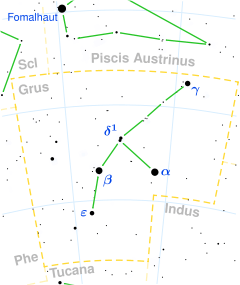Beta Gruis
Beta Gruis (β Gruis, abbreviated Beta Gru, β Gru), formally named Tiaki /tiˈɑːki/,[12] is the second brightest star in the southern constellation of Grus. It was once considered the rear star in the tail of the constellation of the (Southern) Fish, Piscis Austrinus: it, with Alpha, Delta, Theta, Iota, and Lambda Gruis, belonged to Piscis Austrinus in medieval Arabic astronomy.[13]
| Observation data Epoch J2000 Equinox J2000 | |
|---|---|
| Constellation | Grus |
| Right ascension | 22h 42m 40.05027s[1] |
| Declination | −46° 53′ 04.4752″[1] |
| Apparent magnitude (V) | 2.146[2] (2.0 - 2.3[3]) |
| Characteristics | |
| Evolutionary stage | AGB[4] |
| Spectral type | M5 III[5] |
| U−B color index | +1.757[2] |
| B−V color index | +1.620[2] |
| Variable type | SRb[3] |
| Astrometry | |
| Radial velocity (Rv) | +1.6[6] km/s |
| Proper motion (μ) | RA: +135.16[1] mas/yr Dec.: −4.38[1] mas/yr |
| Parallax (π) | 18.43 ± 0.42[1] mas |
| Distance | 177 ± 4 ly (54 ± 1 pc) |
| Absolute magnitude (MV) | −1.61±0.052[7] |
| Details | |
| Mass | 2.4[8] M☉ |
| Radius | 180[9] R☉ |
| Luminosity | 2,500[9] L☉ |
| Surface gravity (log g) | 0.4[9] cgs |
| Temperature | 3,480[10] K |
| Metallicity [Fe/H] | 0.0[9] dex |
| Other designations | |
| Database references | |
| SIMBAD | data |
Nomenclature
β Gruis (Latinised to Beta Gruis) is the star's Bayer designation.
It bore the traditional Tuamotuan name of Tiaki.[14] In 2016, the IAU organized a Working Group on Star Names (WGSN)[15] to catalog and standardize proper names for stars. The WGSN approved the name Tiaki for this star on 5 September 2017 and it is now so included in the List of IAU-approved Star Names.[12]
In Chinese, 鶴 (Hè), meaning Crane, refers to an asterism consisting of Beta Gruis, Alpha Gruis, Epsilon Gruis, Eta Gruis, Delta Tucanae, Zeta Gruis, Iota Gruis, Theta Gruis, Delta² Gruis and Mu¹ Gruis.[16] Consequently, Beta Gruis itself is known as 鶴二 (Hè èr, English: Second Star of the Crane).[17] The Chinese name gave rise to another English name, Ke.[18]
Properties
This is a red giant star[3] on the asymptotic giant branch[4] with an estimated mass of about 2.4 times that of the Sun and a surface temperature of approximately 3,480 K,[10] just over half the surface temperature of the Sun. This low temperature accounts for the dull red color of an M-type star. The total luminosity is about 2,500 times that of the Sun, and it has estimated 180 times the Sun's radius.[8]
Beta Gruis is a semiregular variable (SRb) star that varies in magnitude by about 0.4. It varies between intervals when it displays regular changes with a 37-day periodicity and times when it undergoes slow irregular variability.[3]
References
- van Leeuwen, F. (November 2007), "Validation of the new Hipparcos reduction", Astronomy and Astrophysics, 474 (2): 653–664, arXiv:0708.1752, Bibcode:2007A&A...474..653V, doi:10.1051/0004-6361:20078357
- Gutierrez-Moreno, Adelina; et al. (1966), "A System of photometric standards", Publ. Dept. Astron. Univ. Chile, Publicaciones Universidad de Chile, Department de Astronomy, 1: 1–17, Bibcode:1966PDAUC...1....1G
- Otero, S. A.; Moon, T. (December 2006), "The Characteristic Period of Pulsation of β Gruis", The Journal of the American Association of Variable Star Observers, 34 (2): 156–164, Bibcode:2006JAVSO..34..156O
- Eggen, Olin J. (July 1992). "Asymptotic giant branch stars near the sun". Astronomical Journal. 104 (1): 275–313. Bibcode:1992AJ....104..275E. doi:10.1086/116239.
- Houk, Nancy (1978), "Michigan catalogue of two-dimensional spectral types for the HD stars", Ann Arbor : Dept. of Astronomy, Ann Arbor: Dept. of Astronomy, University of Michigan, 2, Bibcode:1978mcts.book.....H
- Wielen, R.; et al. (1999), "Sixth Catalogue of Fundamental Stars (FK6). Part I. Basic fundamental stars with direct solutions", Veröff. Astron. Rechen-Inst. Heidelb, Astronomisches Rechen-Institut Heidelberg, 35 (35), Bibcode:1999VeARI..35....1W
- Park, Sunkyung; et al. (2013), "Wilson-Bappu Effect: Extended to Surface Gravity", The Astronomical Journal, 146 (4): 73, arXiv:1307.0592, Bibcode:2013AJ....146...73P, doi:10.1088/0004-6256/146/4/73.
- Gondoin, P. (December 1999), "Evolution of X-ray activity and rotation on G-K giants", Astronomy and Astrophysics, 352: 217–227, Bibcode:1999A&A...352..217G
- Judge, P. G. (November 1986), "Constraints on the Outer Atmospheric Structure of Late Type Giant Stars with IUE Application to Alpha-Tauri K5III and Beta-Gruis M5III", Monthly Notices of the Royal Astronomical Society, 223 (2): 239, Bibcode:1986MNRAS.223..239J, doi:10.1093/mnras/223.2.239
- Engelke, Charles W.; Price, Stephan D.; Kraemer, Kathleen E. (October 2006), "Spectral Irradiance Calibration in the Infrared. XVI. Improved Accuracy in the Infrared Spectra of the Secondary and Tertiary Standard Calibration Stars", The Astronomical Journal, 132 (4): 1445–1463, Bibcode:2006AJ....132.1445E, doi:10.1086/505865
- "V* bet Gru -- Variable Star", SIMBAD, Centre de Données astronomiques de Strasbourg, retrieved 2010-01-05
- "Naming Stars". IAU.org. Retrieved 16 December 2017.
- Allen, R. H. (1963), Star Names: Their Lore and Meaning (rep ed.), New York, NY: Dover Publications Inc., p. 238, ISBN 0-486-21079-0
- "WG Triennial Report (2015-2018) - Star Names" (PDF). p. 7. Retrieved 2018-07-14.
- "IAU Working Group on Star Names (WGSN)". Retrieved 22 May 2016.
- (in Chinese) 中國星座神話, written by 陳久金. Published by 台灣書房出版有限公司, 2005, ISBN 978-986-7332-25-7.
- (in Chinese) 香港太空館 - 研究資源 - 亮星中英對照表 Archived 2008-10-25 at the Wayback Machine, Hong Kong Space Museum. Accessed on line November 23, 2010.
- Richard Hinckley Allen: Star Names — Their Lore and Meaning: Grus
